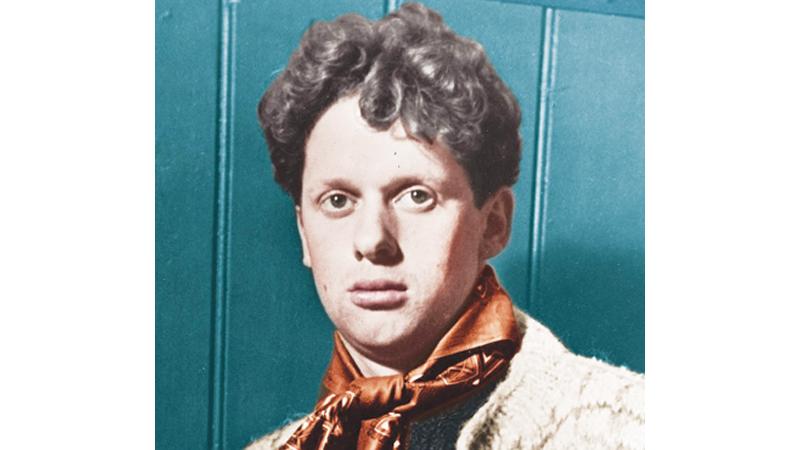
The difference between these two Bards; one from Wales and the other from England, is the language they used centuries apart. Dylan Thomas could never reach even a striking distance to his predecessor, so he settled down to poetry that became his forte. That was a wise decision and became a wizard at it.
What I like most about visiting the Dylan Thomas Centre are the different paths that lead to it. From the busy town centre of Swansea to the beachfront on a bright sunny day dotted with hundreds of fishing boats and the idyllic woods winding its way with a couple of wooden bridges along another path, can be very exciting. This is an annual pilgrimage when I visit my brother every year who lives in Swansea very close to the Centre. It has been so for over three decades and the Centre stay-put the same way but with different international and national programs organised, some of which grants scholarships to bright young people. Also, literary and Dylan Thomas experts are organised when they appear from around the world to update his works.
Life of a poet
He was a passionate and tragic man and although primarily a poet, he also published film scripts, short stories and performed his works and also conducted radio broadcasts. One of his most famous works, ‘Under milk wood’ was a radio play for voices which continued a poetic sensibility.
His most famous poem is arguably, ‘Do not go gentle into that good night’, containing the lines ‘Rage, rage against the dying of the light. This was the account of the scene which haunted him at his father’s deathbed. In less than following this event, Dylan himself collapsed in New York, consumed by alcoholic poisoning and died shortly afterwards. Throughout his life, Thomas experienced a melancholy which was the catalyst to his alcohol abuse. One of his many world-famous friends was former US President, Jimmy Carter who campaigned for Thomas to be commemorated within Westminster Abbey.
In 1995 Jimmy Carter opened the Dylan Thomas Centre in Swansea. The Centre is the focus for an annual Dylan Thomas Festival. Swansea is also the home to the Dylan Thomas Theatre and his bronze status literally sits nearly. His birthplace in the Uplands district of Swansea can also be viewed.
The bard of Wales, If the English are proud of their poet, William Shakespeare, so are the Welsh of their Bard, Dylan Thomas. Born in 1914 on a hill above the Uplands which has a view of his lovely town of Swansea with its sweeping bay. His mother Florence Williams came from St. Thomas on the east side of Swansea and his father from Johnstown was senior English master of the old Swansea Grammar School on Mount Pleasant Hill.
Thomas had already started to write while he was a pupil at the Grammar School. (so much like Shakespeare’s beginnings) Four note books of his schoolboy verse were a major source for the poetry he published during the 1930s. At this time, he and a group of friends, most of whom were artists or writers later, met regularly in the Kardoman Cafe. These brilliant young men created what has been called Swansea’s ‘Golden age’ of culture. After a short period working as a reporter with the South Wales Daily Post, Thomas moved to London. Here he shared the studio with Alfred Janes, the Swansea painter. He published his first three books of poems in 1936 25 poems in 1938 and ‘The Map of Love’ in 1939.
He was introduced to Caitland Macnamara by artist Augustus John and the following year he married Caitland. They had two sons and a daughter. His adult life was tempestuous because he drank heavily and engaged himself in wild and erratic behavior.
In the spring of 1949 Thomas moved over to the Boat House in Langhorne with Caitland. The house was bought for him by a friend. It was built on overlooking the Towy estuary that provided many images which Thomas celebrated in his book, ‘Deaths and Entrances’ in 1946.
He disliked the narrow-minded local people as a teenager and hebetates it is his early poems but later when he looked back on his hometown with nostalgia, he realised they were his inspiration.
Under the milk wood
The classic he wrote with a setting as a play for voices which he wrote for the radio. It was a great achievement for him. ‘Under milk wood’ was Produced on stage in the USA.
Thomas made four visits to America to give poetry readings, the last two being to publish his ‘Collected poem’ of 1934-1952 in 1952. The collection was awarded the prestigious Foley’s Literary Prize. By this time Thomas was acclaimed as one of the greatest living lyric poets. He had plans to collaborate on a work with composer Stravinsky but unfortunately it was not to be.
What a great score it would have made
Dylan Thomas passed away on 9 November 1953 in a New York hospital after a bout of drinking. He was only thirty nine years old. Thomas’s body was brought back to Wales and is buried in St. Martin’s churchyard at Laugharne.

